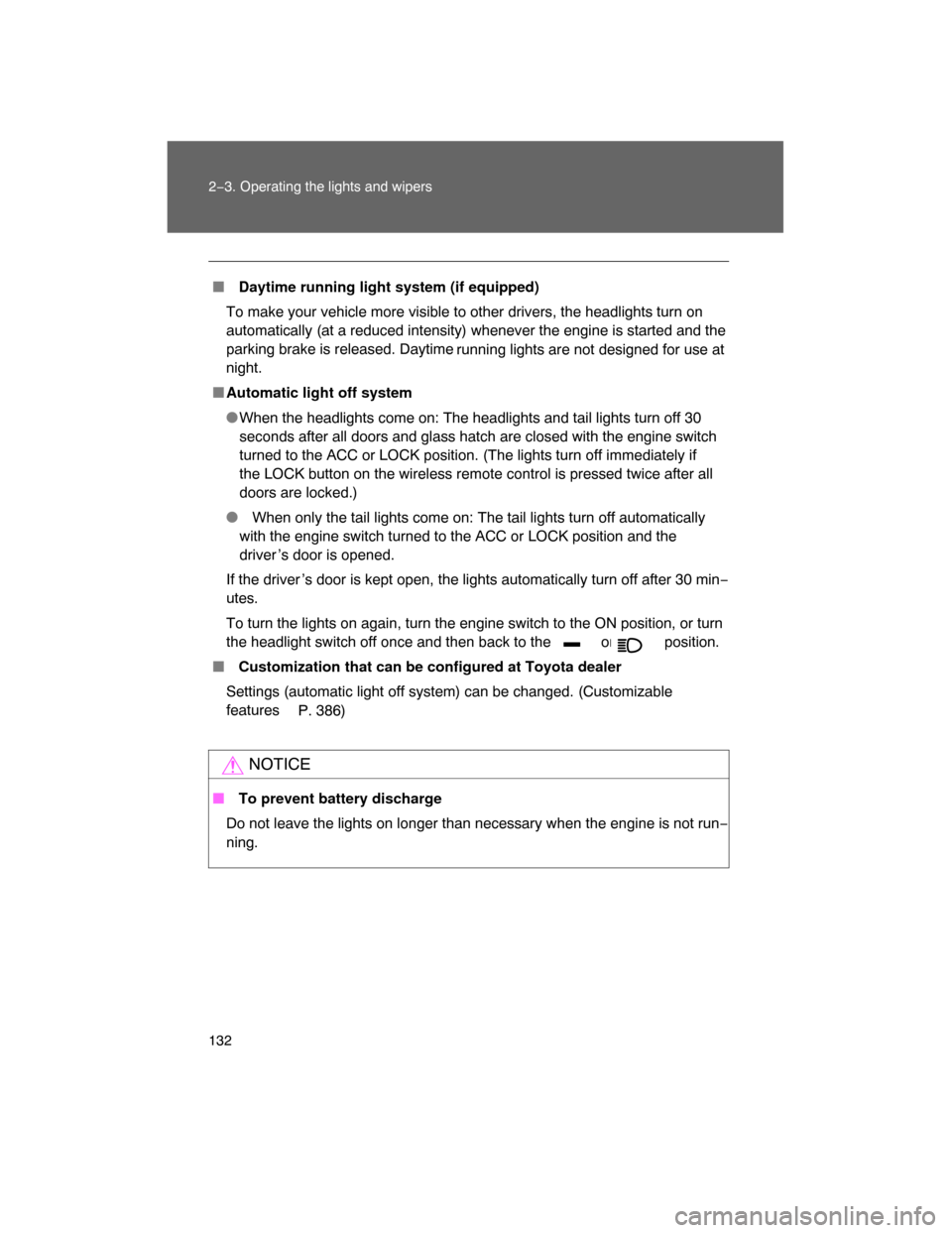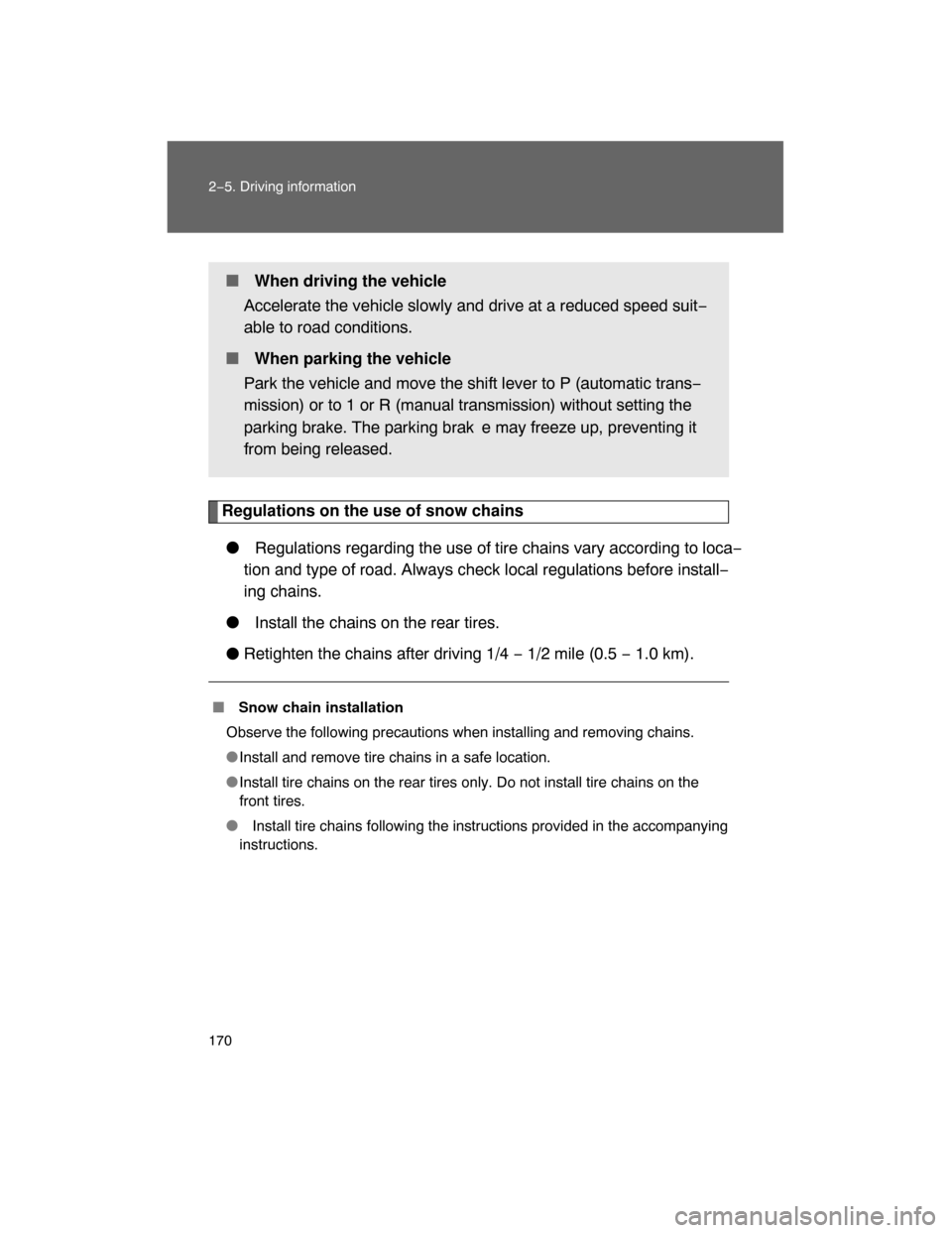Page 110 of 400

112 2−1. Driving procedures
NOTICE
� When driving the vehicle
Vehicles with a manual transmission
�Do not rest your foot on the clutch pedal while driving.
Doing so may cause clutch trouble.
� Do not use any gears other than the first gear when starting off and mov−
ing forward.
Doing so may damage the clutch.
� Do not use the clutch to hold the vehicle when stopping on an uphill grade.
Doing so may damage the clutch.
Vehicles with an automatic transmission
�Do not use the accelerator pedal or depress accelerator and brake pedals
together to hold the vehicle on a hill.
� When parking the vehicle
Vehicles with an automatic transmission: Always put the shift lever in P.
Failure to do so may cause the vehicle to move or the vehicle may acceler−
ate suddenly if the accelerator pedal is accidentally depressed.
� Avoiding damage to vehicle parts
� Do not turn the steering wheel fully in either direction and hold it there for a
long time.
Doing so may damage the power steering pump.
� When driving over bumps in the road, drive as slowly as possible to avoid
damaging the wheels, underside of the vehicle, etc.
�If you hear a squealing or scraping noise while driving (brake pad wear
limit indicators)
Have the brake pads checked and replaced by your Toyota dealer as soon
as possible.
The rotor damage can result if the pads are not replaced when needed.
It is dangerous to drive the vehicle when the wear limits of the brake pads
and/or that of the brake discs are exceeded.
Page 112 of 400
114
2−1. Driving procedures
Engine (ignition) switch
� Engine switch
LOCK
The steering wheel is locked
and the key can be removed.
ACC
Some electrical components
such as the audio system can
be used.
ON
All electrical components can
be used.
START
For starting the engine.
� Starting the engine
Automatic transmission
Check that the parking brake is set.
Check that the shift lever is set in P.
Sit in the driver ’s seat and firmly depress the brake pedal.
Turn the engine switch to the START position and start the
engine.
Manual transmission
Check that the parking brake is set.
Check that the shift lever is set in N.
Firmly depress the brake pedal and clutch pedal.
Turn the engine switch to the START position and start the
engine.
Page 115 of 400
117
2−1. Driving procedures
2
When driving
Automatic Transmission (if equipped)
Select a shift position appropriate for the driving conditions.
� Shifting the shift lever
While the engine switch is on, depress the brake pedal and
move the shift lever.
� Shift position uses
*: To improve fuel consumption and reduce noises, set the shift lever in
D for normal driving.
Shift positionFunction
PParking the vehicle or starting the engine
RReversing
NNeutral
DNormal driving*
4Position for engine braking
3, 2Position for more powerful engine braking
LPosition for maximum engine braking
Page 120 of 400
122
2−1. Driving procedures
Par king brake
� Set the parking brake
Fully set the parking brake
while depressing the brake
pedal.
At this time, the indicator will
come on.
� Release the parking brake
Slightly raise the lever
Press the button
Lower it completely
Page 121 of 400
123
2−1. Driving procedures
2
When driving
NOTICE
� Before driving
Fully release the parking brake.
Driving the vehicle with the parking brake set will lead to brake components
overheating, which may affect braking performance and increase brake
wear.
Page 130 of 400

132 2−3. Operating the lights and wipers
� Daytime running light system (if equipped)
To make your vehicle more visible to other drivers, the headlights turn on
automatically (at a reduced intensity) whenever the engine is started and the
parking brake is released. Daytime
running lights are not designed for use at
night.
�Automatic light off system
�When the headlights come on: The headlights and tail lights turn off 30
seconds after all doors and glass hatch are closed with the engine switch
turned to the ACC or LOCK position. (The lights turn off immediately if
the LOCK button on the wireless remote control is pressed twice after all
doors are locked.)
� When only the tail lights come on: The tail lights turn off automatically
with the engine switch turned to the ACC or LOCK position and the
driver ’s door is opened.
If the driver ’s door is kept open, the lights automatically turn off after 30 min−
utes.
To turn the lights on again, turn the engine switch to the ON position, or turn
the headlight switch off once and then back to the or position.
� Customization that can be configured at Toyota dealer
Settings (automatic light off system) can be changed. (Customizable
features
P. 386)
NOTICE
� To prevent battery discharge
Do not leave the lights on longer than necessary when the engine is not run−
ning.
Page 140 of 400

142 2−4. Using other driving systems
� Sensor detection information
� Certain vehicle conditions and the surrounding environment may affect
the ability of a sensor to correctly detect an obstacle. Particular instances
where this may occur are listed below.
�There is dirt, snow or ice on a sensor.
�A sensor is frozen.
�A sensor is covered in any way.
�The vehicle is leaning considerably to one side.
�On an extremely bumpy road, on an incline, on gravel, or on grass.
�The vicinity of the vehicle is noisy due to vehicle horns, motorcycle
engines, air brakes of large vehicles, or other loud noises producing
ultrasonic waves.
�There is another vehicle equipped with parking assist sensors in the
vicinity.
�A sensor is coated with a sheet of spray or heavy rain.
�The vehicle is equipped with a fender pole or radio antenna.
�A bumper or sensor receives a strong impact.
�The vehicle is approaching a tall or right−angled curb.
�In harsh sunlight or intense cold weather.
�The area directly under the bumpers is not detected.
Objects lower than the sensors or thin stakes etc. may be detected ini−
tially, but as they draw closer, they may cease to be detected.
�A towing hitch is mounted to the vehicle.
�A non−genuine Toyota suspension (lowered suspension etc.) is
installed.
In addition to the examples above, there are instances in which, because of
their shapes, signs and other objects may be judged by a sensor to be closer
than they are.
� The shape of the obstacle may prevent a sensor from detecting it. Pay
particular attention to the following obstacles:
�Wires, fences, ropes, etc.
�Cotton, snow and other materials that absorb radio waves
�Sharply−angled objects
�Low obstacles
�Tall obstacles with upper sections projecting outwards in the direction
of your vehicle
Page 168 of 400

170 2−5. Driving information
Regulations on the use of snow chains
� Regulations regarding the use of tire chains vary according to loca−
tion and type of road. Always check local regulations before install−
ing chains.
� Install the chains on the rear tires.
�
Retighten the chains after driving 1/4 − 1/2 mile (0.5 − 1.0 km).
� Snow chain installation
Observe the following precautions when installing and removing chains.
�Install and remove tire chains in a safe location.
�Install tire chains on the rear tires only. Do not install tire chains on the
front tires.
� Install tire chains following the instructions provided in the accompanying
instructions.
� When driving the vehicle
Accelerate the vehicle slowly and drive at a reduced speed suit−
able to road conditions.
� When parking the vehicle
Park the vehicle and move the shift lever to P (automatic trans−
mission) or to 1 or R (manual transmission) without setting the
parking brake. The parking brak e may freeze up, preventing it
from being released.